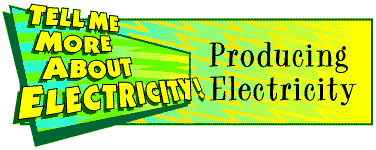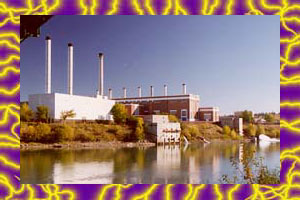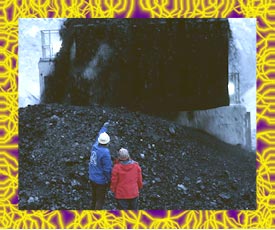 |
Most of the electricity consumed in North America is generated using coal, oil, natural gas, nuclear energy or hydropower. Some production is done with alternative fuels like geothermal energy, wind power, biomass, solar energy, or fuel cells.
The electricity you buy may be generated using one or more of these methods. No matter what fuels produce the electricity you use, your lights shine, your radio plays, and your computer runs in the same way.

Hydropower
Hydroelectric plants use the power of falling water to turn the turbines that help generate electricity. Water stored behind a dam is released and directed through special tubes to flow against the blades of turbines and make them turn.
Fossil Fuels
The majority of electricity used in North America is generated from power plants that burn fossil fuels (coal, oil, and natural gas) to heat water and make steam. The highly pressurized steam is directed at the blades of turbines to make them spin.
Coal, oil, and natural gas are known as fossil fuels because they were formed from the fossilized remains of animals or plants that lived long ago. Long ago, even before the dinosaurs, these plants and animals died and settled to the bottom of lakes and oceans to be covered over by sand and mud. Over millions of years, the earth's pressure and heat converted their remains into coal, oil, and natural gas.
Coal is extracted from the ground at large mines. Coal is used to generate about half of the electricity used in the North America.
Natural gas and oil are obtained through wells drilled deep in the earth.
Nuclear Power
Nuclear power plants use the heat from splitting atoms to convert water into the steam that turns turbines. These plants rely on uranium, a type of metal that must be mined from the ground and specially processed. Fuel rods containing uranium are placed next to each other in a machine called a nuclear reactor. The reactor causes the uranium atoms to split and in so doing, they release a tremendous amount of heat.
 Geothermal
Energy
Geothermal
Energy
Steam (or hot water converted to steam) from under the ground is used to turn turbines.
 Wind
Power
Wind
Power
The force of the wind is used to spin many small turbines. Most wind power is produced from wind farms-large groups of turbines located in consistently windy locations.
Biomass
Biomass is organic matter, such as agricultural wastes and wood chips and bark left over when lumber is produced. Biomass can be burned in an incinerator to heat water to make steam, which turns a turbine to make electricity. It can also be converted into a gas which can be burned to do the same thing.
 Solar
Energy
Solar
Energy
Solar energy is generated without a turbine or electromagnet. Special panels of photovoltaic cells capture light from the sun and convert it directly into electricity. The electricity is stored in a battery.
Fuel Cells
Fuel cells produce electricity through a chemical reaction.
![]() Next:
Pioneers of Electricity
Next:
Pioneers of Electricity![]()
![]() Previous:
Electricity Basics
Previous:
Electricity Basics![]()
